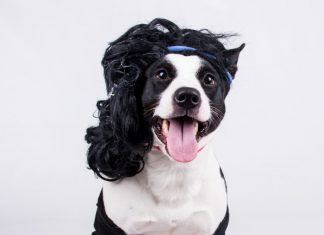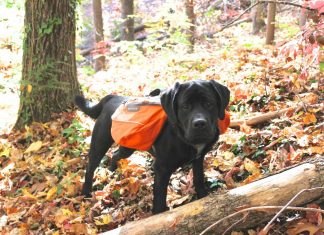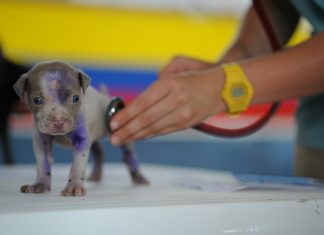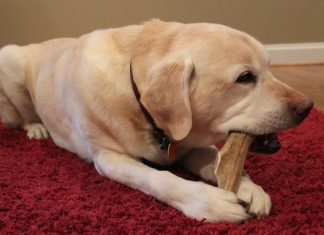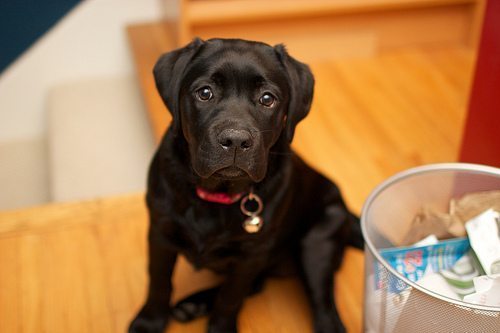 Wagbrag is excited to publish an exclusive interview with John C. Wright, Ph.D., a renowned Certified Applied Animal Behaviorist (CAAB). Susan Giordano, Wagbrag’s expert on dog training and behavior modification, recently had the opportunity to speak with Dr. Wright about several animal behavior topics. The topic below, Socializing Your Puppy, is the first in a two-part series describing our conversation with Dr. Wright.
Wagbrag is excited to publish an exclusive interview with John C. Wright, Ph.D., a renowned Certified Applied Animal Behaviorist (CAAB). Susan Giordano, Wagbrag’s expert on dog training and behavior modification, recently had the opportunity to speak with Dr. Wright about several animal behavior topics. The topic below, Socializing Your Puppy, is the first in a two-part series describing our conversation with Dr. Wright.
Dr. Wright is presently a Professor of Psychology at Mercer University. He is an ABS Certified Applied Animal Behaviorist (1991), and a Charter Fellow of the Association for Psychological Science (1988). As a CAAB, Dr. Wright holds a highly exclusive designation requiring an advanced degree (Ph.D. or DVM), as well as hands-on experience as a practitioner, adherence to ethical standards and regular scholarly publication on related topics.
Dr. Wright offers dog and cat behavior seminars and workshops across the nation. He has spoken internationally to the National Dog Warden’s Association (UK) and to several organizations within the U.S., including The American Veterinary Medical Association and the National Animal Control Association. Dr. Wright also has a successful veterinary referral house-calls practice in Atlanta (since 1980).
Susan: Let’s talk puppies. I often get asked about the trade-offs between keeping a new puppy healthy and socializing it early. How can a new puppy owner strike a balance between keeping puppy safe from disease until they have been fully vaccinated, and getting them socialized between the ages of 7 and 18 weeks, which we know is a critical learning phase?
Dr. Wright: That’s a great question, and an issue that we all face when raising a new puppy, or advising others on how to do so. The central question here is whether keeping the puppy away from others, in order to keep it safe from disease, may bring it even more harm. By not socializing early and correctly, you may risk the pup having to be euthanized in extreme cases, or at a minimum not being the best s/he can be, due to the lack of socialization and exposure to other pups and to humans. When puppies are not correctly socialized, they may become biters because they are afraid of new things that they were never properly exposed to (note: a fearful dog will bite if s/he feels there is no other way to protect himself). Also, puppies need exposure to a variety of sounds and sights in order to become more comfortable with these stimuli throughout that critical learning period.
On the other hand, if you expose puppies to all kinds of animals before they’ve had their vaccinations, they will have a higher risk of acquiring a disease. The puppy could die from the disease, or risk chronic health problems for the rest of their lives. So – unfortunately there is not a clear-cut answer here.
Many Veterinary Behaviorists suggest that the puppy at least have the first round of shots given before they are exposed to a proper socialization environment, such as a well-controlled “puppy kindergarten” class. These classes are good, because they offer the pup a chance to gain some socialization skills, learn some basic rules, feel what it’s like to be handled and meet different dogs and people in a new environment. While a controlled class can be helpful, it’s probably not a good idea to take your puppy to dog park, where everything is less certain — you don’t know the personalities of the other dogs there, or what immunizations they have received. In addition, try to avoid taking the puppy to the veterinarian too frequently during this pre-immunization time period, due to the risk of exposure to disease. Instead, think about how you can get your puppy the opportunity to play with other puppies you are certain are healthy, and expose him or her to people in a more controlled setting where you are fairly confident that the risk for exposure to disease is relatively small. By following these guidelines, you can help to ensure the physical, physiological and behavioral health of your puppy.
Susan: Often, puppies react differently to fear than adult dogs. I have read that while fearful adult dogs typically respond with a “fight or flight” reaction, puppies often have a third reaction, which can be described as “fidgeting” or “fooling around”. How is it that the shy puppy that hid behind his owner or began sniffing out of context when afraid begins to act aggressively (when afraid) once they reach social maturity? How do they figure that out?
Dr. Wright: That’s a really great question, and we could probably talk forever about it. A couple of things may influence how a dog reacts to fear, including:
- Genetic disposition. As more messages from the genotype start to affect the temperament of the dog as it matures, you get a bit more variability in fear, and it’s more likely to become a trait. So, whereas puppies are still fairly malleable or moldable in terms of their tendency to behave towards things in particular ways, as an adult, sometimes that fear becomes a bit more fixed. So the response becomes more like neophobia (e.g. the fear of any kind of novelty) as the puppy grows up, and that can be a developmental problem that may account for some of those apparent differences between an adult response and a puppy’s response.
- Pet Guardian Behavior. As the puppy grows, he forms social relationships with other puppies and people. If a puppy has a guardian who takes a leadership role, making decisions about what the puppy will do or be exposed to, or what they will not be exposed to, the puppy is more likely to relax as it matures. The puppy will feel more confidence and trust in his pet parent, thinking “Gee, I don’t have to make a decision about this, because my guardian will protect me from this stranger. I’ll just sit here and not be afraid because I trust my person.” Contrast that with a puppy whose guardian waits for the puppy to evaluate and react to a situation, with no help or support. When the dog has to take charge, s/he may get fearful and bite.
Bottom line, it’s a combination of factors and pups are usually much more open to a variety of experiences than older dogs. And at any rate, the older a dog gets, the more likely he is going to react to things in a more specific, predictable way.
Susan: So what’s the best way to make a shy puppy comfortable when you take him out to work on his socialization?
Dr. Wright: Across the board, with any age (and it certainly works with puppies), the best way to ensure a comfortable socialization is to make sure you begin with a fairly low intensity sensory environment. By this, I mean the environment should not be too noisy, there should not be too many visual stimuli and the activity level should be low to moderate. The experience should be one where the puppy can be fairly comfortable with you while experiencing new things, such as a new grassy area or a new park, possibly exploring a parking lot, or perhaps driving around in the car. An example of what you wouldn’t want to do is to drive the puppy around in your car for the first time with 3 or 4 kids in the car being loud or petting the pup. Keep things low key. When taking the puppy to the vet for the first time, maybe you just walk in, say hello, and walk back out. If the sensory environment is controlled for the first one or two exposures, the chances of success will increase. Then the puppy will say, “Oh yes, I’ve been here before, I know what this is like.” After that point, you can begin to add more sensory enrichment and stimuli to the experience, because the pup can take on a little bit more.
Susan: So what should you do if “life” happens during one of the puppies first experiences? For example, what if a group of children get off a nearby bus and start walking towards you and your puppy?
Dr. Wright: If you can anticipate something like this, you can turn puppy around and happily, yet confidently head off into the other direction; if you can’t, you make sure you calmly protect the dog and see if you can distract her from the stimulation as much as possible. The last thing you want to do is just say, “What the heck, let’s see how it goes.” These things need to be planned, to the extent you can. But, to your question — yes, “life happens” and you need to fulfill the expectations the puppy has. If the pup happens to be overwhelmed with things, you should take on the role of protecting the puppy from those things and don’t allow him to have a bad experience. These situations can actually help to build trust when things really count. Down the road as the puppy experiences more things with you and you react in a calm manner, the puppy learns that he doesn’t need to worry so much about new and different things. As he matures, he develops the understanding that he can just sit there and relax, because he knows that you will protect him.
So, to summarize much of our discussion today, the sources of influence that affect the way a dog behaves as an adult are genetics, rearing, and how you control the puppies’ experience in all kinds of environments. The environmental exposure should be varied. The more comfortable experiences you can provide within each new environment, the more that genotype can allow for the expression of all possibilities of good behavior. If you have genetic information that tells the puppy to react to situations in a variety of ways, but you don’t expose the pup to an environment where this behavior can be expressed and learned, then essentially that genotype is being wasted. You have to allow for the range of expression of the genes to take place, and the best way to do that is by introducing your puppy to a variety of environments and ensuring a good experience within them.
Photo: Courtesy of Clownfish via Flickr (CC by 2.0)

